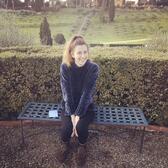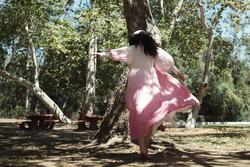Writing on the Walls
It was Shabbat morning in Jerusalem, the air warm and dry under the Mediterranean sun. Little chassidic children ran around under the shade of awnings, hanging on monkey bars and tugging at their mothers’ long skirts. And there, sitting in a misshapen circle on the slightly yellowed grass of the park, were forty-odd Jewish-American college students from lower Manhattan and eight Israeli soldiers, talking about our feelings.
We were discussing walls. Emily, our pink-haired, nose-ringed Birthright Israel educator, had selected this topic in preparation for our trip to the Kotel, or the Western Wall, arguably the most famous wall in the world. Why do we have walls? What do they help us achieve as a society, and in what ways do they harm us or hold us back as a species? There is, of course, the Kotel, which both separates us from the Temple Mount and allows us to get as close as possible to this holy space. It is both a barrier and a conduit. We discussed other kinds of walls, too: the Kotel’s mechitza, the wall that separates the comparatively massive men’s section from the much smaller women’s area; the wall of the “old city” of Jerusalem, which separates the historic area from its larger, more modern counterpart; and, of course, the infamous Wall, topped with barbed wire and dotted with imposing Israeli guard towers, which separates “Israel proper” from the Palestinian territories. This wall goes by many names: border wall, separation wall, apartheid wall. As a group of current IDF soldiers and American students whose politics ranged from right-of-center to outright socialist, we debated terms, wrestled with values, and challenged each other’s preconceived notions.
Less than two months before, in the May of 2018, some of these same students had been present at an annual Yom Ha’Atzmaut event in Washington Square Park, around which NYU’s campus is situated. The event, advertised as the “Rave in the Park”, features loud music, festive dancing, and Israeli flags. It is typically accompanied by an anti-Zionist protest by members of NYU’s Students for Justice in Palestine club and other left-wing activists. That year, in the wake of the Gazan “March of Return” and the subsequent shooting of over two dozen Palestinians by Israeli soldiers, the protest was especially volatile. Videos show one protestor grabbing the mic during the singing of HaTikvah, the Israeli national anthem, and shouting “free Palestine.” Those present at the event also reported that an Israeli flag from the celebration was burned by protesters.
The clash was the culmination of two semesters’ worth of extremely high tensions between anti-Zionist social justice groups on campus and Zionist Jewish students. In 2018, Jewish Voice for Peace (a firmly anti-Zionist Jewish club that frequently butts heads with more mainstream Jewish students) formed a chapter on NYU’s campus, and 52 student clubs released a statement in support of BDS, which included a boycott of two pro-Israel Jewish student groups. The walls, it would seem, are not only in Jerusalem.
I, for one, had spent the better portion of the year struggling with some of my own walls when it came to Israel. I was raised on the kind of deeply joyous and uncritical Zionism which tends to permeate liberal Jewish spaces in America, especially those designed for children and teens, in which nuance and dialogue is eschewed in favor of simplistic narratives and easy answers. I came of age with a basic knowledge of Israeli history and culture, and a deeply-seated love for and pride in my little country in the Middle East, but a minimal understanding of the controversy which surrounds Israel and its relations with the Palestinian people. I had a vague sense, as I approached the end of my high school years, that I had a lot more digging to do when it came to Israel, but hardly knew where to begin. After reading Ari Shavit’s powerful My Promised Land for one of my freshman year classes at NYU, I began to seriously examine my personal relationship with the country. I needed answers. How was it that all the horrible things Shavit writes about—the expulsions, the murders, the detention camps filled with young Palestinian men who dare to throw stones—had never come up in all my years of formal Jewish education? While I colored in blue and white flags at Hebrew School and learned the Mayim step at summer camp, I was deprived of hearing these stories.
I did a significant amount of surface-level research during my freshman year, and finally came to what I had thought was a conclusion: The two-state solution. That sweet, simple green line. It made so much sense. I could be pro-Israel without being a bad progressive; I could smile and nod both in Jewish spaces and in left-wing spaces. It was the perfect halfway point. Nevermind that I had no understanding of how or within what timeframe such an agreement could take place, or that I had never even heard of zones A, B, and C of the West Bank and the different Israeli regulations that govern them. Secure in the intellectual and moral soundness of my underdeveloped political opinion about a country I had only ever been to twice, I proceeded to become very involved in NYU’s new J-Street chapter and even became a board member. I enjoyed the position and felt—and still feel—that I was doing important work. But, as discussions came up that hinged on questions not of war versus peace or good versus evil, but on more specific issues—the necessity (or not) of checkpoints, the definition of the word “Zionist,” what kind of force is real “disproportionate force”—I realized how little I truly knew about the conflict and about my own stance.
Before our discussion that day in Jerusalem, we had visited an Arab-Jewish women’s fair trade collective called Sindyanna of Galilee and spoken to both Palestinian and Israeli staff members. I remember one of my peers asked a Palestinian woman how she felt about working so closely with people who some in her community might consider the enemy. She thought for a moment, before answering in Arabic. “At first,” her translator said, “There is some difficulty. It is hard to trust. But, we change. We do not talk about political things. We talk about our lives, our families. We work together. It is good. This is where peace starts.”
NYU’s Birthright trip did not give me answers. If anything, it only gave me more questions. And for that, I am grateful. Despite its frequent characterization as a “free propaganda trip”—an unfortunate reputation highlighted by high-profile student walk-offs in recent months—my personal experience with Birthright was anything but. Our educators and tour guide took every opportunity to add nuance and complexity to our discussions. When we visited the Bedouin encampment, our tour guide spoke of the challenges the modern state of Israel presents to the traditional Bedouin lifestyle. As we drove past the border wall on our way from Jerusalem to the Judean desert, we discussed the realities of life on the other side of that barrier.
I have made my rounds in the world of Jewish organizations. I have attended Hebrew School. I have attended and worked at a Jewish summer camp. I have done all the summer programs and the educational leadership retreats and the Torah study groups. I know Jewish institutions. What happened on my Birthright trip—organized by New York University’s Hillel—was highly unusual. It is highly unusual for organized Jewish institutions to ask young people to actively interrogate their relationship with the State of Israel. To, as our other educator Omer is fond of saying, “grapple” with our Zionism and with our Judaism, as Jacob once did with the angel.
More often than not in Jewish spaces, Israel is painted with a broad and optimistic brush. It is our Homeland, good and hopeful, light unto the nations, shining and pure. And hey, did we mention they invented the cherry tomato? Israel, it seems, can do no wrong. The work of discovering and processing Israel’s warts, her blemishes, and her fragilities, is left to the young Jewish person, who, upon attending a progressive university, suddenly finds herself the involuntary spokesperson for a country she was told was perfect.
My Birthright experience was not bias-free. Obviously, a free ten-day trip to the Jewish state run by a Jewish organization will never be able to show a comprehensive picture of all sides. Birthright’s mission is to foster a connection between Jews and Israel; this premise is inherently Zionist. I hope that in future years, I will have the opportunity to travel to the Palestinian Territories as well, and gain a deeper understanding of the conflict. But coming from an often polarized campus, NYU Birthright offered me an opportunity to dwell in the gray area. I was able to balance on the edges of the walls and look out onto both sides, to struggle and question and fall in love with Israel anew, for what she really is.








Excellent article. Thank you.